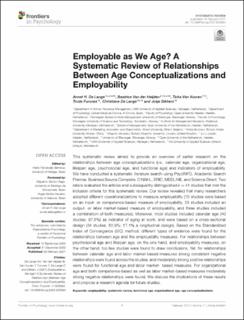| dc.contributor.author | De Lange, Antoinette Harmke | |
| dc.contributor.author | Van der Heijden, Beatrice I.J.M. | |
| dc.contributor.author | Van Vuuren, Tinka | |
| dc.contributor.author | Furunes, Trude | |
| dc.contributor.author | De Lange, Christiane | |
| dc.contributor.author | Dikkers, Josje | |
| dc.date.accessioned | 2021-05-18T09:59:39Z | |
| dc.date.available | 2021-05-18T09:59:39Z | |
| dc.date.created | 2021-03-06T17:44:25Z | |
| dc.date.issued | 2021-02 | |
| dc.identifier.citation | Frontiers in Psychology. 2021, 11:605684 1-14. | en_US |
| dc.identifier.issn | 1664-1078 | |
| dc.identifier.uri | https://hdl.handle.net/11250/2755413 | |
| dc.description.abstract | This systematic review aimed to provide an overview of earlier research on the relationships between age conceptualizations (i.e., calendar age, organizational age, lifespan age, psychosocial age, and functional age) and indicators of employability. We have conducted a systematic literature search using PsycINFO, Academic Search Premier, Business Source Complete, CINAHL, ERIC, MEDLINE, and Science Direct. Two raters evaluated the articles and subsequently distinguished k = 41 studies that met the inclusion criteria for this systematic review. Our review revealed that many researchers adopted different operationalizations to measure employability (15 studies were based on an input- or competence-based measure of employability, 23 studies included an output- or labor market-based measure of employability, and three studies included a combination of both measures). Moreover, most studies included calendar age (40 studies, 97.6%) as indicator of aging at work, and were based on a cross-sectional design (34 studies, 82.9%; 17.1% a longitudinal design). Based on the Standardized Index of Convergence (SIC) method, different types of evidence were found for the relationships between age and the employability measures. For relationships between psychosocial age and lifespan age, on the one hand, and employability measures, on the other hand, too few studies were found to draw conclusions. Yet, for relationships between calendar age and labor market-based measures strong consistent negative relationships were found across the studies, and moderately strong positive relationships were found for functional age and labor market- based measures. For organizational age and both competence-based as well as labor market-based measures moderately strong negative relationships were found. We discuss the implications of these results and propose a research agenda for future studies. | en_US |
| dc.language.iso | eng | en_US |
| dc.publisher | Frontiers Media S.A | en_US |
| dc.rights | Navngivelse 4.0 Internasjonal | * |
| dc.rights.uri | http://creativecommons.org/licenses/by/4.0/deed.no | * |
| dc.subject | alder | en_US |
| dc.subject | eldre arbeidstakere | en_US |
| dc.title | Employable as we age? A systematic review of relationships between age conceptualizations and employability | en_US |
| dc.type | Peer reviewed | en_US |
| dc.type | Journal article | en_US |
| dc.description.version | publishedVersion | en_US |
| dc.rights.holder | Copyright © 2021 De Lange, Van der Heijden, Van Vuuren, Furunes, De Lange and
Dikkers. | en_US |
| dc.subject.nsi | VDP::Samfunnsvitenskap: 200::Psykologi: 260 | en_US |
| dc.source.pagenumber | 1-14 | en_US |
| dc.source.volume | 11 | en_US |
| dc.source.journal | Frontiers in Psychology | en_US |
| dc.identifier.doi | 10.3389/fpsyg.2020.605684 | |
| dc.identifier.cristin | 1896076 | |
| cristin.ispublished | true | |
| cristin.fulltext | original | |
| cristin.qualitycode | 2 | |

